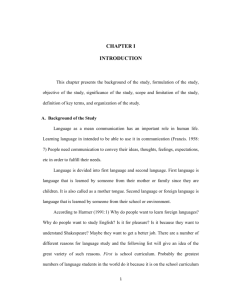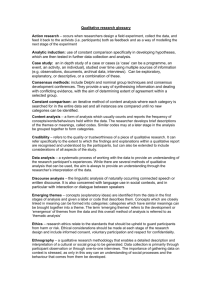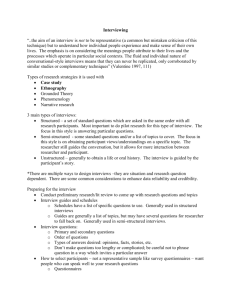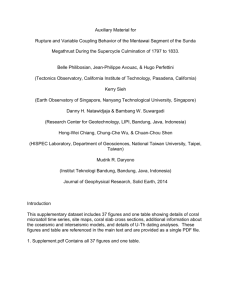chapter iii research methodology
advertisement
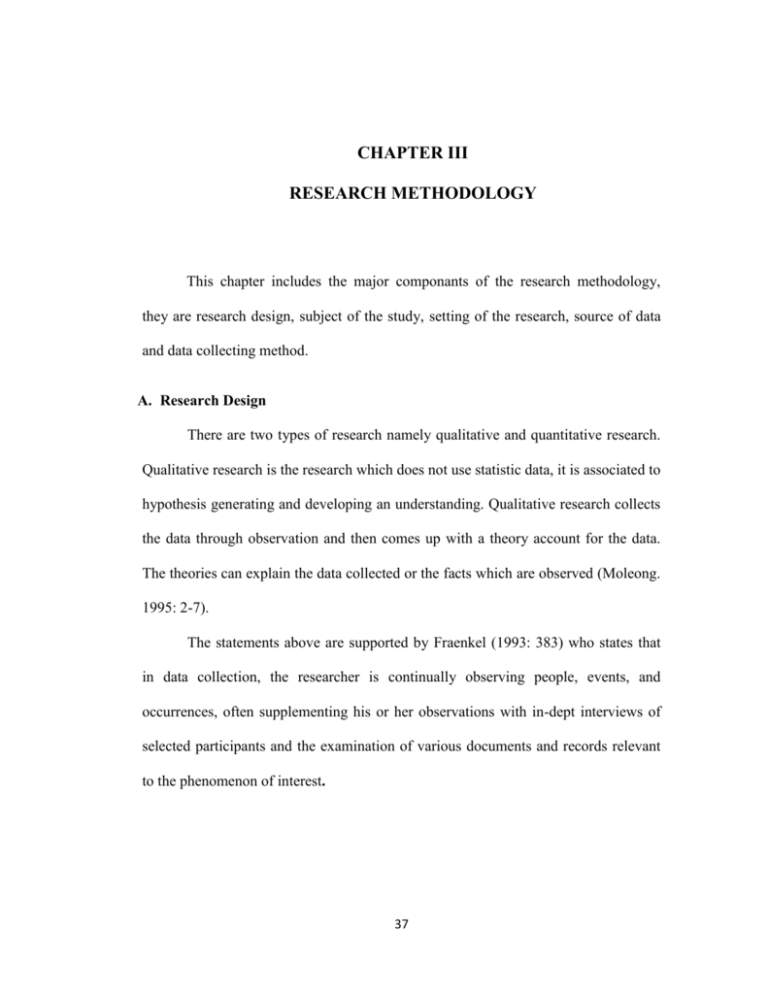
CHAPTER III RESEARCH METHODOLOGY This chapter includes the major componants of the research methodology, they are research design, subject of the study, setting of the research, source of data and data collecting method. A. Research Design There are two types of research namely qualitative and quantitative research. Qualitative research is the research which does not use statistic data, it is associated to hypothesis generating and developing an understanding. Qualitative research collects the data through observation and then comes up with a theory account for the data. The theories can explain the data collected or the facts which are observed (Moleong. 1995: 2-7). The statements above are supported by Fraenkel (1993: 383) who states that in data collection, the researcher is continually observing people, events, and occurrences, often supplementing his or her observations with in-dept interviews of selected participants and the examination of various documents and records relevant to the phenomenon of interest. 37 In this research, the writer tries to conduct descriptive qualitative research. So, the writer describes the process of teaching speaking by using cards at the eighth grade students of MTs N Bandung. B. Subject of the Study The subject of the study is the eighth A-F grade of MTs Negeri Bandung. Every class consists for about 40 students. So, the writer used all classes of eighth grade as the subject of study. C. Object of the Study The object of the study is the process of teaching speaking by using cards to the eight A-F grade of MTs Negeri Bandung. D. Setting of the Research It is important to know the research area. Actually, there is no a certain criteria in determining the research area, but it must be clear where the research is conducted, that principally research is done in a definite place. In this study, the researcher chooses MTs N Bandung as the place of the study. This research was done at 25 May up to 14 June 2012. 38 E. Data and data Source 1. Data The data is information, evidence, or fact gathered through studies or experiments, which can be analyzed in order to get better understanding of a phenomenon or to support a theory (Richard. 1992: 96). Arikunto says (1998: 91), “data is result of research record in number and fact”. It means that data is the number of fact that found by the researcher. The collected data must be relevant with the formulated problem. In this research, researcher uses qualitative data because the data is in the form of fact. 2. Data Sources The sources of data are very significant in the research. The researcher will not be able to get information without knowing sources of data. Arikunto states (1998: 120) that sources of data are subjects who give the data or information or where the data are gotten from. Information or data can be divided into two, based on the sources of data or where the information or data come from. They are primary data and secondary data. a. Primary data source Primary data is the data which is collected by researcher directly from his own observation and experiences. In this research the primary data can be gotten from the direct observation and interviewed with the English teacher about the application of the English community program. Based on the explanation, the 39 primary of data sources in this research are teaching and learning strategies in speaking at English community program that are used by teacher of speaking for the favorite student of English community program. b. Secondary data source Secondary data is data which support and complete the primary data. Suryabrata states that secondary data are usually in the form of collecting of document (Sumadi. 1995: 85). These data are captured from some books, document reference, such as material and syllabus. Based on the explanation, the secondary of data sources in this research are books, internet, that have literatures with research problem, syllabus and geographical of Mts N Bandung. F. Data Collecting method and Instrument Data have very important role in a research, because without data it is impossible to get result of the research. To obtain the data, the research has to use instruments of collecting data, namely: (1) Observation; (2) Interview, and (3) Document. 1. Observation Observation is monitoring with systematic phenomenon which is investigated. In other words, the researcher observes the teaching learning process and drawing conclusion of whatever happen in teaching-learning process by using cards. 40 2. Interview Fraenkel (1993: 385) We interview people to find out from them those things we cannot directly observe. The issue is not whether observational data is more desirable, valid, or meaningful than self-report data. The fact of the feelings, thoughts, and intentions. We cannot observe behaviors that took place at some previous point in time. We cannot observe situations that preclude the presence of an observer. We cannot observe how people have organized the world and the meanings they attach to what goes on in the world. We have to ask people questions about those things. He describes that interview is an important way for a researcher to check the accuracy of the impressions of what he or she has gained through observation. The purpose of interviewing people is to find out their mind, what they think or how they feel about something. 3. Documentation Document is a kind of source data involves anything notes aimed to examine a research (Moleong. 1995: 161). In a research, the researcher may use syllabus, teaching material, lesson plan, and recording interview as the document. 41 G. Data Analysis Method In this research, the writer conducts descriptive qualitative research which describes the process of teaching speaking by cards at the eighth grade students of MTs N Bandung. So, in this case the writer does not need statistic data. The follows are the procedures of analyzing the data: 1. Data reduction Data reduction is started by explaining, selecting the basic thing, focusing on something important to be content of data which derives from the field, so the data reduced can give description deeply to the observation result. 2. Displaying The Data Data display is the process showing data simply in the form of words, sentence, narrative, table, and graphic in order that the data collected is mastered by the researcher as the basic to take appropriate conclusion. Data display include the formulation of the study. 3. Conclusion Drawing If the data has been enough, the data conclusion will be drawn. The researcher will take the conclusion what she studies in her research. 42 To have the clear understanding about the process of the data analysis, this figure shows the above procedures. Data Collection This data are collected through observation, interview and documentation Data Reduction Selecting, simplifing, and organizing those raw data referring of the form of research process T R I A G U L A T I O N Data Display 1. The way of teacher in teaching speaking by using cards 2. The problems teaching speaking using cards 3. Solutiojn taken by teacher 4. System of evaluation Temporary conclusion drawing Final conclusion drawing Data analysis procedure develop by Miles and Huberman 43
